At the same time 1,000 people were rallying for Vision Zero in the streets of New York City last night, Portland’s active transportation advocates and influencers were in a meeting learning about how our city plans to move forward on the issue.
Last month we shared what steps Mayor Charlie Hales and the Bureau of Transportation are taking to make good on their commitments to Vision Zero. And last night, PBOT’s Operations & Safety Manager Gabriel Graff, shared a presentation about Vision Zero with members of the City’s Bicycle Advisory Committee.
It was a stark contrast: New York City is (once again) way ahead of us with their elected officials, advocates, agency leaders, victims, and concerned residents unified and out in the streets demanding changes and moving the conversation forward. While here in Portland, we’re sitting around a table in City Hall hearing about yet another task force, planning process, and more studies.
Advertisement
New York City formally adopted Vision Zero in 2014 with a goal to have zero deaths and injuries by 2024. That’s ten years from now. Portland City Council declined to set a date when they passed a Vision Zero resolution last month, with each council member giving a slightly different excuse as to why. Of course New York City has a “strong mayor” system where the city’s top elected official calls the shots and can make things happen unilaterally — unlike Portland where we take more of a majority-rules/consensus-based approach (and our Mayor isn’t even in charge of the transportation bureau). And of course New York City has a lot more funding to work with.
But I digress…
Graff’s 21-slide presentation was a Vision Zero primer. Most of it was a basic outline of what Vision Zero is and why it’s important for PBOT to focus on. The final two slides are the ones worth noting.
Graff shared a draft version of the specific indicators PBOT will use to measure their Vision Zero progress…
If PBOT monitors all of these things and openly shares the data at regular intervals, that would be a great step forward. To make progress on this stuff, we’ve got to first have a baseline.
And then there was the familiar flow-chart of how the planning process will play out. As you can see below, PBOT hopes to adopt the final Vision Zero Action Plan in October 2016 following a 16-month process that will kick off next month with a meeting of the Vision Zero Executive Committee and the Vision Zero Task Force (I’ve asked for the membership list of both groups and will update this post when I get it)…
I understand the need for an implementation plan, but it seems the whole idea of Vision Zero is to make changes immediately. After all, City Council and PBOT have already endorsed language saying that they won’t accept any further fatalities or serious injuries on our streets. It will be interesting to see what steps they are able to take before this plan is adopted 16 months from now.
Stay tuned. We plan to watch closely as PBOT continues to figure out how to integrate Vision Zero into their work.
NOTE: I did not make it clear enough in this story that this long-range plan is a multi-agency effort and that PBOT is working more immediately on the 17 Vision Zero action items included in their 2-Year Workplan.




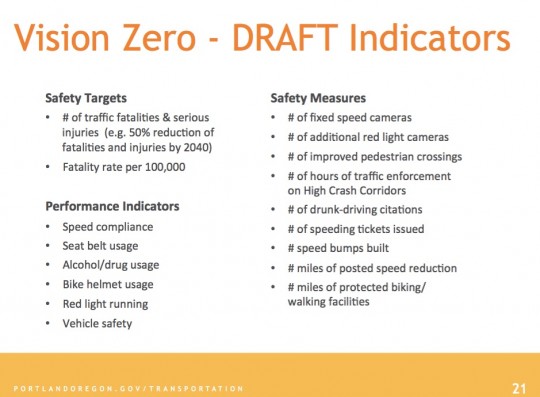
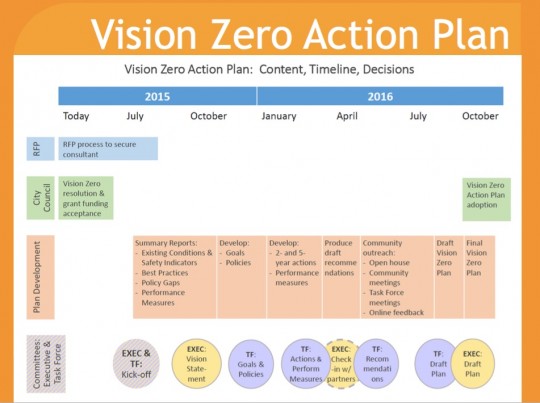
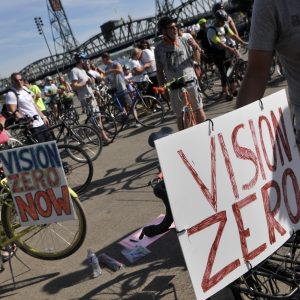
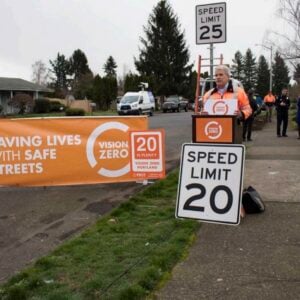


Thanks for reading.
BikePortland has served this community with independent community journalism since 2005. We rely on subscriptions from readers like you to survive. Your financial support is vital in keeping this valuable resource alive and well.
Please subscribe today to strengthen and expand our work.
A good step forward, but the reality on the street needs much improvement.
sorry to hijack the top spot, but has everyone commenting here sent an email here?
safe@portlandoregon.gov
If you haven’t, get your ship together, send an email, flood the inbox, and then return to comment here. while you’re at it, fill out reports here also:
nearlykilled.me
A 50% reduction is not Vision Zero. (I know that’s just an example given, but to be Vision Zero, it needs to be a goal of 100% reduction. Why even give that example?)
Also, focusing on bike helment usage is the wrong approach. People driving cause nearly all injuries and deaths of people riding bikes; focus should be put solely on them.
This all just smells like more talk and no action. Business as usual for Portland.
Let’s keep up the pressure and protests. Don’t let the city think that this “committee” is enough.
Also, sixteen months?! How hard is it to come up with a plan that essentially copied from other cities? Here, I’ll come up with a plan in sixteen seconds: make driving harder and more inconvenient, build more protected bike lanes and sidewalks. It really is that simple. There are plenty of examples worldwide to take for our own use. I know, every politician wants to come up with their own plan and leave their own legacy, but if the end results are zero deaths, who cares what their “special” plan was? Ugh.
/endrant
“How hard is it to come up with a plan that essentially copied from other cities? ”
I’m going to be especially interested to see what PBOT comes up with. I predict that the sixteen months are needed to persuade the powers that be/staff/whoever to abandon their paternalistic anti-pedestrian/pro-car bias. If you compare how SF and NYC have gone about this, how much effort their materials devote to wagging fingers at pedestrians for not wearing bright clothing, or jumping out of the way of cars (=zero) with how PBOT does (has done) this, we have at least sixteen months of unlearning ahead of us.
PBOT:
http://bikeportland.org/2014/06/20/pbot-ad-campaign-drivers-slow-107630#comment-5247325
ODOT:
http://bikeportland.org/2014/10/31/vision-0-08-major-safe-streets-effort-must-tackle-alcohol-112928#comment-5723825
I agree with you, this is going to take a culture shift to not automatically put car travel above all else and treat bike/walk/public transport as an afterthought. I can maybe see that taking sixteen months.
…a 50% reduction over the next 25 years.
If we just consider traffic fatalities, of which Portland reportedly had 28 in 2014, a target of 50% reduction over 25 years would mean about 1 less fatality every two years.
I find a 16 month planning period to be exceptionally long. This is not a new idea, there are other places where this has been implemented, why should we need a year and a half to put together next steps?
What makes it hard is trying to figure out how to make streets safer without affecting drivers.
Hilarious. I wish it weren’t so close to being true.
That logo?! A heart-shaped cake and oven mitts…?
Who comes up with this stuff?
I’m glad you clarified the logo as oven mitts. I thought it was a recommendation for motorists how they could drive without having their hands on the wheel – use your wrists so you can keep your hands free for texting.
About that logo. Money well spent?
Here is a selection of vision zero logos that a 5 second google search turned up: https://www.google.com/search?q=vision+zero+logo&tbm=isch&tbo=u&source=univ&sa=X&ved=0CB4QsARqFQoTCOCmyai66sYCFc1aiAoduzoKGQ&biw=976&bih=637
I like the German catchphrase especially:
KEINER KOMMT UM, ALLE KOMMEN AN
which translates as NO ONE DIES, EVERYONE ARRIVES
http://www.dvr.de/bilder/pm_juli08_visionzero2b.jpg
or how about the straightforwardly declarative one from NYC –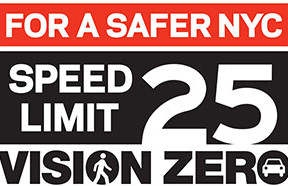
FOR A SAFER NYC
SPEED LIMIT 25
VISION ZERO
Maybe the “oven mitts” are meant to convey that we’re going to try to make driving something that one could do safely even with oven mitts on, i.e., clumsy mistakes shouldn’t necessarily be fatal to you or others. Possible? Hmmmm.
“…cake…”
“Bake in a slow oven for 16 months…”
I am mostly joking about not affecting drivers, but I can very easily imagine a “safety campaign” implemented New York-style where draconian crack-downs on the double scourge of jaywalking and bicyclist speeding are the main pillars. That and a new mandatory helmet law…
Yes, and unless we have a government willing to NOT listen to the complaints of drivers, Vision Zero is not even worth thinking about. Drivers in the US are under-regulated, underpunished when they screw up, and grotesquely undertaxed. Until this changes, expect no improvement.
So in their column called “Performance Indicators”, it has one of them being “Bike helmet usage”. I hope they realize when the time comes to assess their results that high helmet usage is a sign of failure.
The only way helmet usage should be on there is if helmet usage going down is considered a positive, indicating that people feel safer bicycling.
Also, I’ve biked a handful of times in SE PDX without a helmet since I forgot to wear one recently; there’s a HUGE difference in the way drivers treated me without a helmet versus with one. When I had no helmet on they were infinitely more courteous, cautious, and far less likely to even consider passing me no matter how slow I was going. With the helmet on they treat me like I’m a rodent running alongside them that they’re just barely trying to avoid killing.
They should replace that indicator with bike mode share, since that metric actually correlates with safety.
What I’m missing here (I wasn’t invited to the meeting) is any sense of vision. We are about to undertake a city-wide redesign in an effort to heal the wounds of nearly a century of infrastructure built to exclude humans. If done right this is an opportunity for Portland to maintain it’s place as a world leader, defining the terms of human centric cities for the next generation.
I don’t sense any of that enthusiasm in this city’s approach so far. Election season can’t come any sooner.
thanks for covering this Jonathan. Was there any mention of distracted driving? This is far more serious threat to than bicycle helmet use and needs to be immediately addressed to improve general safety for VRU(s).
Sixteen months completely wasted! The cost in staff time will probably run to $500,000. Completely wasted! Maybe a consultant, too. Completely wasted!
Look at the damn “Safety Measures.” I’m all for increasing the number of citations for drunk driving and for speeding, but those haven’t figured in several of the recent, high-profile collisions where motorists killed or injured cyclists or pedestrians. If Portland adopts those safety measures, there won’t be any “credit” for those entirely inadequate, once-a-month pedestrian enforcement actions. Where’s the commitment to citing motorists for passing too closely or driving in the bike lane or driving over diverters? You achieve the results you measure and this draft list doesn’t hit many of the right things.
As others have pointed out helmet usage is one of the “performance indicators.” Wow. Great. We can spend money doing surveys to track whether helmet use is increasing or decreasing. What a f%#@ing waste of resources.
How about we focus on just DOING things that have already been proven? How about some serious commitment to ENFORCEMENT from the mayor, commissioners, PPB and the DA? How about getting the PPB spokesman to utter the words “the motorist was at fault and MULTIPLE citations are pending” instead of “no citations have been issued?” How about a commitment to prosecute some of the motorists who kill or seriously injure cyclists?
A completely bureaucratic response seeking to accomplish absolutely nothing while pretending to take citizens’ concerns seriously. Platinum city? Yeah, you bet.
For that matter, has anyone killed someone else by not wearing a seat belt? Sure, wearing a seat belt is important, but if you personally wish to be flung from your car when you get in a crash, how does that affect me as another road user?
Good point – we should eliminate the seat belt and air bag requirements in cars. After all, if you want to run the risk of being on the street with inadequate safety equipment, it should be your personal choice.
Under ‘Performance Indicators’, there are lots of ‘indicators’ that provide for more safety for others on the road than ‘Seat Belt Usage’. How about ‘Cell Phone Usage’, ‘Turn Signal Usage’, ‘Side Mirror Usage’, ‘Basic Speed Law Compliance’, ‘Safe Passing Distance’, ‘Crosswalk Compliance’, etc etc.
And yet, drivers still get tickets for not wearing a seatbelt, and you can’t buy a car without air bags.
It should be a personal choice, like wearing a motorcycle helmet…
There are still plenty of cars on the road without seat belts. In addition, some collisions are actually multiple collisions. A car may strike another car in an intersection, for example, then spin around and crash into a power pole or parked car. The airbag may protect in the initial collision and be deflating before the second impact.
Sorry. I meant plenty of cars without airbags.
Random and Dan,
How do your musings reduce fatal crashes for people in cars? Vision Zero includes all road users, and people in cars are currently the largest share of those dying in Portland.
Actually, as of 2014, over twice as many pedestrians died in Portland as did people in cars; I’ll bet they didn’t die from tripping and hitting their heads on the sidewalk.
However, I would indeed hate to see “Vision Zero” turn into yet another flavor of bicyclist- and pedestrian-safety campaign. If it is sold as a way to make everyone, especially drivers, safer, then it might be more well-tolerated than something perceived as a bunch of new, inconvenient rules I have to follow just to keep them safe.
I provided some examples in the musing above.
There may actually be some merit to the idea that improved automobile safety devices contributes to more reckless driving.
It has been proven, especially with road design. If you make a road wider and add guard rails, people will drive faster. If you make a car large and very safe, people will drive faster. For decades, federal policy has been to mandate auto safety devices, and “safe” road design (barriers, divided highways, etc), rather than focus on actual safe infrastructure that protects people both in and outside of the cars.
This is what’s wrong with America:
http://news.yahoo.com/blogs/abc-blogs/pa-couple-tired-cars-crashing-home-161937936–abc-news-topstories.html
“The couple has wanted to put a boulder in front of their house to prevent accidents from damaging their home, but they said they have been told that such an obstacle would make them liable for any damage to a rogue driver.”
“For decades, federal policy has been to mandate auto safety devices, and “safe” road design (barriers, divided highways, etc)”
And these measures have largely worked – road fatalities on a per mile basis are far lower in the United States than most of the rest of the world.
You really think that having the road infrastructure of a Third World country (no barriers, no divided highways, etc.) would improve auto safety?
Road fatalities for occupants have gone down.
“Road fatalities for occupants have gone down.”
LOL. Yeah, right. You think fewer pedestrians are killed in counties that have Third World roads?
Related to your story, here’s a house in my neighborhood, on a curve in a 25mph zone:
https://www.google.com/maps/@45.534719,-122.833332,3a,75y,343.08h,76.56t/data=!3m6!1e1!3m4!1sNdiYPK7PLWjToT6iwX3Wfw!2e0!7i13312!8i6656
Note the rock wall and set of bollards meant to prevent cars from flying off the road and into their yard.
That exact thing happened to my across-the-street neighbor several years ago. A lady coming around the curve forgot to steer, I guess, and went straight across the oncoming traffic lane, across their lawn, over a boulder, through some shrubs, hit the corner of their garage, bounced off and rolled down the driveway into a light pole and over a phone box, and back across the street, ending up “parked” facing the wrong way on my side of the street. I was home at the time, and from inside my house, it sounded like my next-door neighbor had dropped a full wooden crate of china off their 2nd-floor lanai.
I’m glad my house is on the inside of the curve.
And that is one of the reasons I’m an education and enforcement type and not an infrastructure type.
I see blaming everything on infrastructure (ad as these examples point out don’t necessarily stop a moving motor vehicle) kind of like victim blaming (or at the least blame shifting), but in this case the victim is an inanimate object that can’t defend itself.
And really, it shouldn’t have to defend itself from the bad decisions and behavior of people that should know better.
Chris,
Can you reference some of the ‘proof’?
the unintended consequences of Ralph Nader
I actually think this is a good idea. In fact, if we eliminated crumple zones and replaced it with a system that would send shrapnel flying through the cab of the motor vehicle when it crashes into something would make people start to pay a LOT more attention and be less inclined to drive too close to other objects, be they other cars, bicyclist, signs, trees, buildings, etc.
I’m only partly joking. People feel incredibly safe in their giant steel boxes loaded with safety features, and take risks accordingly.
I think the word “vision” was inadvertently added to the title of the city’s plan.
Lower posted speed limits and enforcement is the first step to changing culture. Do it tomorrow.
Really, you could announce THIS MORNING that police will now start strictly enforcing the speed limit. It’s just a change in policy, and the public would catch on real quick. Why wait 16 months?
16 months from now is right around when people start paying attention to the election.
As most here know, PBOT only has authority related to statutory speeds. ODOT controls all non-statutory speeds in Oregon. If you want lower overall speeds, one step is to legislate the statutory speeds lower, or perhaps into ranges local jurisdictions could use.
everything else is talk…
If we enforced the speeds as posted it would make a big difference.
I’ve mentioned this before, but in my neck of the woods we requested speed enforcement on a 35mph street, and the sheriff told us he wouldn’t bother pulling over people doing less than 50.
just enforcing the current speed limit would be a huge change and make a world of difference
It feels more like zero vision than vision zero.
sigh – helmet usage -Really? I hope we’re talking in cars.
It always upsets me when I visit a construction site or industrial plant, and they insist that I wear a hard hat.
I point out that wearing safety equipment should be a personal choice, and that it should be their responsibility to secure equipment so that it doesn’t fall on my head – obviously, since any accident won’t be my fault, it’s not my responsibility to wear safety equipment.
They just get all snippy about how everyone has to wear what they refer to as “personal protective equipment”. Keeping me safe should be their problem – I shouldn’t have to do anything about it.
Yeah, a wrench getting dropped on a hard hat is going to work. Getting run over by an Excursion with a bike helmet isn’t. If you’re trying to make a point, use better examples.
“Yeah, a wrench getting dropped on a hard hat is going to work. Getting run over by an Excursion with a bike helmet isn’t.”
A hard hat isn’t going to help you if you have a 500 pound load of cement dropped on you, either. Accidents have a range of severity.
Bike helmets save lives and stop brain injuries – you have zero credibility if you claim to support Vision Zero and don’t support mandatory bike helmet laws, like they have in Seattle.
If you work at a site where 500lb loads are regularly falling out of the sky and killing 33,000 people a year, you’ve got bigger problems than plastic hats.
We’ve reduced motor vehicle fatalities per 100 million VMT by three-quarters since the 1970’s.
It’s not as if we haven’t been making progress on this. The fraction of the US population killed in motor vehicle accidents is the lowest it’s been since the 1920’s.
I don’t disagree with you on helmets being a wise choice, and perhaps a mandatory helmet law would be a good thing. But cyclists aren’t dying because they’re not wearing helmets, they’re dying from getting run over. In terms of meeting the goals of VZ, helmet use should be at the very bottom of the list. Not absent from the list but not high either.
” In terms of meeting the goals of VZ, helmet use should be at the very bottom of the list. Not absent from the list but not high either.”
I think it might be interesting to look at how other jurisdictions rank these things. My hunch would be that very nearly all the Vision Zero energy (column inches) are devoted to reining in the car menace, and almost no energy (column inches) are devoted to wagging fingers at people not in cars. If you know otherwise I’d be very interested to see the examples.
And maybe looking at other jurisdictions could speed up that 16 month timeline as well 🙂
absolutely.
The national government has taken down all stats on the subject of helmet effectiveness because they can’t find a viable claim of effectiveness that passes scrutiny.
The best stats we have now is a survey of the most reliable studies which puts their effectiveness between 0%-25%. Pretty large margin of error, but it also includes the data where helmets increase the chances of neck injuries. Oh wait no one ever talks about that – personally I’m not sure which is worse a skull fracture or a broken neck.
And sorry for the tone of my reply. Upon rereading it, it sounded way nastier than I intended it to. My apologies.
There is a big difference between a hard hat and helmet. I too work construction and have to wear one, and the hard hat has taken the blow a few times for me (a lunch box from two stories) and my co workers. Though I often can get out of it while I’m welding.
Hard hats are designed for a completely different purpose than bicycle helmets. It’s not a fair comparison. Had I been wearing a bicycle helmet when that cooler fell on my head, I would have been injured. The hard hat took some of the blow then shifted it all off my head as it fell off with the lunch box. Helmets don’t divert the blow like that.
Though I agree that I hate how high vis is now required on all job sites. Those vests are wearable napalm for us that play with fire.
I’m pretty sure Carhart makes Flame Retardant Hi Viz. Or maybe I’m thinking arc flash but that would be FR as well wouldn’t it?
Fire departments do NOT like speed bumps.
We need chicanes, not speed bumps.
they like them more than urban gridlock…
Neither do speeders. ‘Chicanes’ require a high level of design to effectively slow speeders and not be something they can evade.
If you make them easy for fire trucks to evade, you’ve basically made them easier for everyone.
Do you have a design in mind? One we could evaluate?
Portland has a Major Emergency Response route classification on which speed bumps are not permitted. This is the solution, not abandonment of one of the most effective and low cost speed reduction tools available.
Steel bollards filled with concrete on each side of the street 18 ft of lanes between them, every block or so. Ideally, at the crosswalk — might even prevent some right hooks.
It should also be noted that, weak though it is, Portland’s efforts will likely not include Powell Blvd., 82nd, etc., as long as they are state highways. ODOT has not adopted any Vision Zero plan. I believe their plan is: Make it safer as long as it doesn’t reduce throughput.
ODOT has a “Toward Zero Deaths” effort. This is kind of like vision zero “lite” and generally follows a very conventional approach to traffic safety.
http://www.oregon.gov/ODOT/GOVREL/pages/news/031912.aspx
“vision zero ‘lite'”
“Vision Partial Zero”
I hate to be the one to defend ODOT, but…
When you look at the map of deaths and serious injuries, look at outer Stark, 122nd, outer Division, Marine Drive. They all have far higher death/injuries than the ODOT roads. All are PBOT streets.
Relative to PBOT, ODOT has been very good at trying out new safety techniques in East Portland, on its roads (82nd, outer Powell, outer Sandy). True, the “pedestrian lane” along outer Powell has been an incredible failure, as car drivers us it and the bike lane as passing lanes, but at least they tried. ODOT has built most (7) of the “rapid flashing beacon” crossing built so far in East Portland, and funded another 18 using funds meant for outer Powell Blvd. The 18 that PBOT has been hyping, as (part of) their response to Vision Zero.
Meanwhile, PBOT has “funded” over $30 million in new bike and and pedestrian projects in East Portland, but is very slow about actually building any of them. When asked, PBOT says that “they are in design”, “60% designed”, “the designers were moved to another project”, etc. Nothing about actual construction.
Here in East Portland, it is hard to not be highly cynical about PBOT. Every five years or so, they announce some new plan “to fix East Portland”. Now it is Vision Zero, with speed cameras, rapid-flashing beacons, diverters, etc. In the past, it was red-light cameras, crosswalk stings, greenways, etc. 5 years from now it will be round-abouts and rotaries.
Joy, another 16 months of continued PBOT inaction, 16 months of more deaths and injuries.
How exciting, A committee presented their powerpoint presentation that align targets, indicators and measures into a synergistic action plan with results that will begin to commence to start improving road safety. I feel safer already.
And a logo. Don’t forget the logo!
Oh yea, oven mitts. The key to safe strudel extraction.
So many buzzwords…
I’ve always viewed the seatbelt as essential to remaining in control of the vehicle during emergency maneuvers. Of course, when you need that in a city, you’re already in the “recovery zone” aka sidewalk and probably because of excess speed and lax enforcement. At least they’ve listed speed compliance first. Sadly, this plan to plan to write tickets is less effective than writing tickets.
WHOSE CHILD WILL HAVE TO DIE BEFORE OUR ELECTED OFFICIALS REALIZE THEY HAVE BLOOD ON THEIR HANDS?
When will they show leadership if they won’t when human life is at stake?
We can blame the culture of highway worship that leads ODOT, or PBOT staff afraid of angry neighbors who complain about losing “their” parking, or we can look at the real problem, which is a group of politicians afraid of their own shadows.
50% reduction by 2040 is an insult. It is a slap in the face.
Say it out loud, “No one in city government cares if I die in a crash.”
Done right, Vision Zero is good for equity. It is good for the environment.
Portland should be proud, should be enthusiastic, to embrace Vision Zero.
And I apologize if I come across as angry or mean. This is about my life and the life of my kids. I take this very personally.
I’m taking bets on what our elected Portland leaders will implement first, this plan or the Mountain Bike Master Plan.
When are we electing them?
I am sorry, but when I look at Portland’s draft and I see data/information from the other cities I believe Portland needs serious help with metrics. To be successful, metrics/targets must be clearly measurable. The list of performance indicators, to me, does not seem measurable.
The only numbers that could possibly be counted are the ones where someone gets caught. That clearly does not indicate the actual numbers. How can they possibly measure these?
They have listed a lot of safety measures, which I guess is their list of means to an end, but not necessarily leading to actual results.
Where are the hard, focused metrics. Where is the partnering with organizations such as hospitals to collect data on injuries, causes, seriousness? Where is the partnering with organizations such as, ABC, to measure mode share increase because people see the streets as being safer? Where are the metrics for reduced average speeds on our greenways, or supposed greenways.
I hope the task force really pushes on making the city sweat to accomplish Vision Zero and not just put out something so they can easily pat themselves on the back.
the lameness of the City’s approach is staggering!
Why not just just adopt another city’s VZ plan in its entirety, and have a committee evaluate it for 6 months then make changes, evaluate for another 6 months, more changes, 6 more months of evaluation, then permanent policy!
I wish we could get someone from PBOT to pipe up here once a week or once a month, even, to answer some of these reasonable questions. Without any answers directly from them we’re left to speculate, and somehow PBOT never looks very good when we’re left to do that. A shame, really.